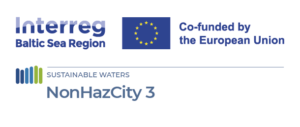Small and medium size enterprises represent 99% of all businesses in the EU. Compliance with legal requirements* with respect to chemical management might comprise a huge potential for hazardous substance** emission reduction. Often, however, smaller businesses outside the chemical sector don’t believe that they use hazardous substances in their operations while in fact; very few workplaces use no chemicals hazardous to health and/or the environment
The latest publication “Hazardous substance reduction potential at local businesses“ systematized pilot actions for emission reductions within the NonHazCity project and gives best practice examples to empower other municipalities to support hazardous substance reduction activities in businesses in their territories.
From the perspective of hazardous substance reduction potential, businesses were important for NonHazCity for three reasons: first, because of occupational exposure in the workplace, second because business activities may involve the use of hazardous substances that are later released into wastewater and the environment and third, articles or items produced or sold by businesses may contain hazardous substances.
The NonHazCity team searched for a few pilot businesses in the partner municipalities to implement concrete hazardous substance reduction measures. Business sectors that were identified as target groups included car care facilities, laundries and dry cleaners, cleaning services, hair and beauty salons, hotels, child & elderly care facilities, and many others. These sectors are end users of numerous chemical products and articles and are often particularly poorly informed about workplace chemical risks. Thus, the potential for both hazardous substance reduction and occupational safety and health improvement are high.
In the EU the hairdressing sector employs more than one million people who work across about 400.000 to 500.000 hairdressing salons. The majority of hairdressing salons are small establishments with, on average, less than three employees. The cleaning sector constitutes one of the most important service providers as well. In 2006, about 3.6 million workers were contracted in 129,000 European companies. There is a considerable congruence of hazardous substances present in products used in the hairdresser/cosmetic sector and the cleaning sector, e.g. chemical groups like surfactants, preservatives or fragrances are likely similar and occupational problems are not uncommon. Studies have shown that respiratory diseases including asthma and skin diseases like dermatitis are common amongst people working in this sector
Being both source and pathway, businesses can reduce their hazardous substance footprint by substitution activities and good chemical management practices. Both emissions and exposure can be reduced as well as avoiding the passing of more hazardous substances down the supply chain. This can be done in many ways depending on the individual approach and practices of each business. Actions can range from application of personal protection measures, use of warning labels in workplaces to substitution or complete elimination of hazardous substances, thus moving towards greater occupational and client safety as well as decreased environmental exposure.
*Restrictions on hazardous substances are set in national and EU chemicals legislation including REACH.
**Hazardous substances are chemicals that are physical hazards (e.g., flammable/explosive) and/or harmful to the health of organisms and ecosystems.

